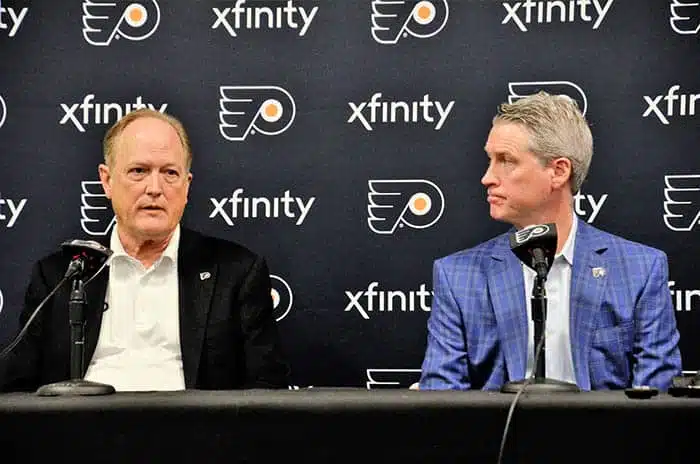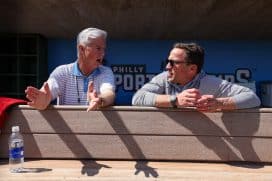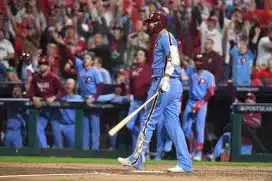Flyers
After Another Reality Check, Flyers Can’t Choose to Accept It

The 2022-23 Philadelphia Flyers season is one that will overall be widely forgotten, at least from an on-ice standpoint. The start of the season was among the least anticipated in franchise history after an underwhelming offseason where an “aggressive retool” was promised. The Flyers were only halfway in on that approach.
As the other sports franchises in Philadelphia made championship runs, the Flyers were under the radar, essentially non-existent. But there has been plenty of attention on the franchise in the last handful of days. These few days served as a reminder of why the Flyers are in such trouble, of why the anticipation is at an all-time low, of why there are questions of if they can be saved at all.
On Tuesday afternoon, GM Chuck Fletcher addressed the media for the first time in nearly three months. With three days to go until the trade deadline, he assured that the team was selling. He insisted the team needed to get younger. He acknowledged that the talent disparity was still too wide.
But Fletcher also tried to pass off that the messaging had been consistent all season long, coming from the GM that wanted to remind you that the team was only five points out of a playoff spot in December. He tried to cover up the team’s failing by somehow mentioning that the team was the fifth most-improved in the NHL in points percentage, a hail mary attempt to take the attention off the shortcomings of the last decade. And in expressing the desire to get younger, he glossed over the numerous contracts that are to players who will be signed well into their 30s.
For Fletcher, all this ever was going to be was words. If he wanted to insist the team was selling, he somehow had to show it in those final three days before the trade deadline, as a flurry of trade deadline activity had already occurred around the league.
When the 3 p.m. deadline hit, the Flyers had made three total trades involving a minor-league forward and two fourth-line forwards. Their most obvious trade chip, a veteran forward with 297 career goals and 585 career points in 920 career games, was not able to be moved. Hell, Fletcher admitted he couldn’t even get so much as a firm offer for him.
So when the deadline passed, James van Riemsdyk remained a Philadelphia Flyer. So did Justin Braun. So did any player signed beyond the 2022-23 season that had been in the rumor mill for weeks.
The Flyers learned the hard way that the market dried up quickly and what the rest of the league thought of what they had to offer. They could have brought more to the table and had some more room for flexibility if not for other missteps.
Last trade deadline, while Claude Giroux was always going to be the biggest name on the move, Rasmus Ristolainen could have been moved to recoup some of the draft picks they had traded away to acquire him. Instead, the Flyers gave the 28-year-old a five-year contract extension. They traded three more draft picks away for Tony DeAngelo in the offseason. They signed 32-year-old Nick Deslauriers to a four-year contract with a no-move clause. They rushed to get an eight-year extension completed with Travis Sanheim by the season opener, when no doubt he would have been their most valuable trade chip at this deadline if they had let the season play out.
Getting younger? “We’re selling?” Hardly.
It takes every message that the team has and makes it hollow. The letter to season ticket holders about this being a process and trying to do it right, the consistent comments from head coach John Tortorella, none of it matters on days like this. Days like this only further show the ineptitude that the front office has in this rebuild process.
If you needed any further reminder of Chuck Fletcher’s incompetence and inability to do the job of truly rebuilding the Flyers, you got it on Friday.
But don’t let all of this sit on Fletcher any longer. He’s only a part of the problem. As the Flyers lost their final game before the trade deadline on Wednesday to the New York Rangers at Madison Square Garden South, the management box was occupied by the likes of two previous general managers in the franchise’s history that make up 25 of the last 30 years of front-office management.
Three of the team’s four senior advisors are players who very much helped build the franchise from the footers in their earliest days. Bobby Clarke, Paul Holmgren, and Bill Barber are all still a presence around this franchise. There is just as much blood on their hands for what this once-proud franchise has become.
Clarke and Holmgren have less involvement in day-to-day decisions and more or less advise on the more significant ones, like coaching hires. Barber serves as essentially an assistant to Dave Scott, Chairman and CEO of Comcast-Spectacor, the person who holds the keys to any sort of rebuild going forward.
Fletcher knows that too. Following the disastrous deadline day, Fletcher’s response to his job security was telling.
“As we go forward, we recognize we have to get more talent and we are going to build it. I’m not worried about my job – whatever happens with me will happen with me,” Fletcher said. “That’s up to Dave Scott. But everything I do is about doing what’s right for the Philadelphia Flyers and not taking shortcuts, and that’s in part why we didn’t make any more deals today.”
Well, Dave Scott, time’s yours.
The current regime has proven time and time again over the last five years that they are not capable of getting this franchise in the right direction or even on the path to it. The advisors have also allowed it to happen. The fan base has fully recognized what the Flyers have become – a rudderless franchise with no sense of direction and no urgency to move forward into the rebuild process that has been apparent for nearly a decade.
If Scott can’t recognize this now, if the advisors cannot see the organizational malpractice that continues to take place, if the advisors who were once part of Stanley Cup winning teams in the glory days of the franchise can watch a rival team’s fans take over the building and accept that, then there is no saving the Flyers.
It’s a sad reality, but one that can be the springboard to action. The choice is in the hands of the Flyers highest-appointed figures. You can accept this reality of being the laughing stock of the NHL and accept the growing distance between yourself and as loyal a fanbase as there is in sports or you can finally do something about it.
Time’s yours.












































